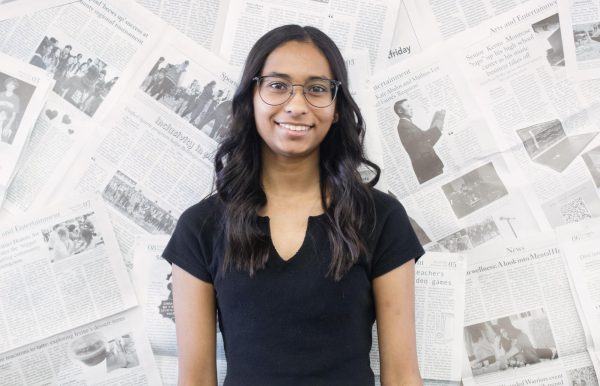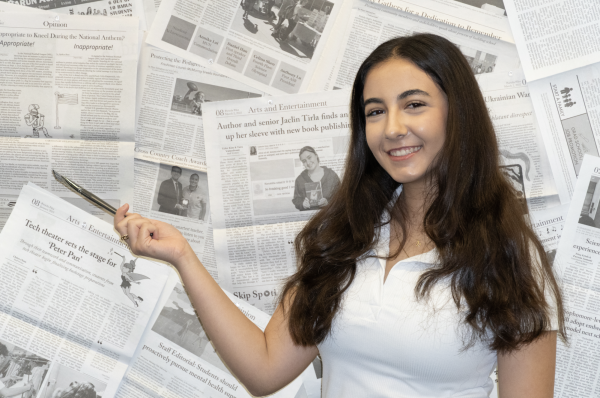AI Art Will Always Stay Artificial
While artificially generated art can be produced at a faster rate, it is not comparable to the beauty of human-made art. “I think that [art] often ties into self expression and ties into processing how you’re feeling or what’s going on in the world and being able to communicate in that way, and those are pretty complex, big things to do,” visual arts teacher Kearci Thompson said. “So it’s not as interesting to most people that study art because we’re like, okay, [the AI] can do some of the things kind of well, but it doesn’t have that human aspect that draws you in.”
The robots must be stopped! Their new focus? Conquering the world of art.
Advances in machine learning processes have paved the way for artificial intelligence artwork in which a human’s skills are replicated to a greater extent. In retrospect, the idea of taking a set of instructions, such as dissecting a picture’s elements to form a new one, has the potential to replace fields that require a sense of creativity.
Despite the convenience and efficiency of AI software, it is vital to value the importance of traditional methods of producing art. AI art is never truly original, and these easily generated pieces of art often distort or reuse artists’ work in order to create a “new” piece.
Art created by computer-generated software is not new; the first computer-generated piece of art was created by American Computer Scientist Harold Cohen in 1973. Despite the possibility of superseding the position of artists, the world of AI art has continued to expand with new software, such as DALL-E. This software is accessible for public use on the internet and can generate pieces of art in a matter of seconds.
“I think one concern I have with [AI art] is how often it uses other artists’ work to make it,” visual arts teacher Kearci Thompson said. “I wonder if those artists themselves really consent to the use of it, especially if it might threaten their livelihood or, you know, make their work feel less valuable because there’s just kind of a way to generate it.”
AI art depends on the recreation of multiple pieces combined, contradicting the core value of composing unique and meaningful pieces of art based on individual interpretation. This means that AI software use artists’ work without any form of acknowledgment or payment to the artist.
“I think that’s something that AI can’t really get,” Thompson said. “It’s just computer-generated art. It’s going to take everything that’s been made and make something again, which works in some settings, but I don’t think that is the purpose of art.”
Although artists and machines are beginning to merge, there is no reason why the two spheres of abstraction cannot run parallel to each other instead. In fact, introducing technology pressures artists to divert from their style, so a separate space should be left for those with a more technical hand who want to push their creativity through code.
“I don’t think it limits traditional artists; they still are able to create the amazing artwork that they do,” AP Computer Science Principles teacher Derek Zahn said. “But I think it also can open up a new pathway for those who kind of express themselves through code to also design pieces of art and have their code recognize more visual and artistic ways.”
Writing code on a computer does not account for the storytelling journey an artist goes through, from the initial thought to the final masterpiece; it merely showcases the author’s ability to take multiple images and create a new one within minutes. This is not as valuable in comparison to the experience of dedicating time and effort to create meaningful art.
“From the way it looks like right now, [AI Art is] pretty negative, because I have a bunch of artist friends, and they’ve complained about AI art and how they’re seeing it everywhere,” senior Summer Hsieh said. “It’s almost disrespectful to the community because they can spend a lot of time making this art, then AI can steal and mash art from different artists and formulate something within five seconds that looks realistic enough to pass as someone else’s art.”
Though the notion that significant advances in technology are only beneficial is widespread, artists’ creative outlets cannot be sacrificed. Valuing the diverse interests of art students is important, but working to conserve traditional art is imperative to showcasing completely unique pieces.
Your donation will support the student journalists of Portola High School. Your contribution will allow us to purchase equipment and cover our annual website hosting costs.

Ruhi Samudra is an Editor-in-Chief for her third and final year on the Portola Pilot. She’s looking forward to being her best social butterfly self this...

Shaina Taebi is the Backpage Editor for her third year in the Portola Pilot. For her final year she is excited to spend class time drawing more editorial...



![While artificially generated art can be produced at a faster rate, it is not comparable to the beauty of human-made art. “I think that [art] often ties into self expression and ties into processing how you're feeling or what's going on in the world and being able to communicate in that way, and those are pretty complex, big things to do,” visual arts teacher Kearci Thompson said. “So it's not as interesting to most people that study art because we're like, okay, [the AI] can do some of the things kind of well, but it doesn't have that human aspect that draws you in.”](https://portolapilot.com/wp-content/uploads/2022/11/Screen-Shot-2022-11-03-at-9.25.15-PM-900x556.png)
